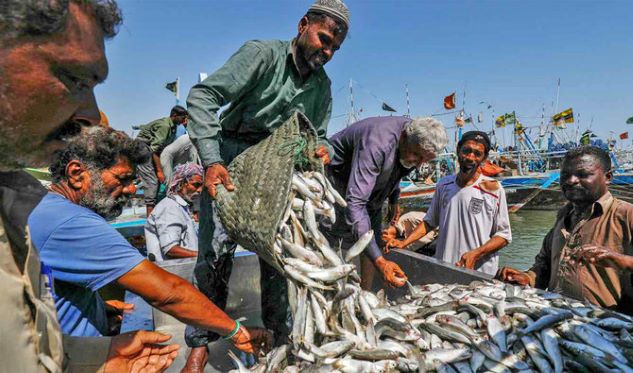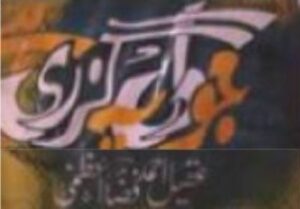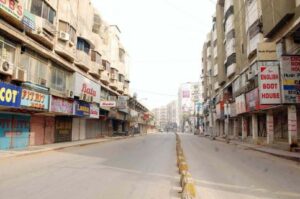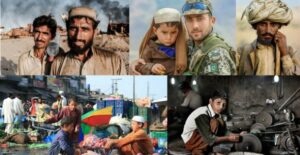Pakistan’s fishing industry — a big catch

By Shahid Rizvi
Fish and fish products can earn more foreign exchange than its present achievement of 1 percent of GDP. It is evident from the target achieved in 1993, as compared to the performance of 1990 which was 84,000 mt valued at Rs. 1,89,47,77,000 as against 309,802 mt valued at rupees 5.5 billion in 1993, that is an increase of 82 percent in quantity and 193% in value over the figure of 1990. Besides, the income from prawns, lobster crabs, etc., what is the brand you have from Rs. 3.5 billion in 1993.
The annual increase in the quantity of catch during the decade of 1981-90 was 5.2% which is not satisfactory keeping in view the richness of our coastal areas of Sindh and Baluchistan which are considered as the best in Southeast Asia.
The rate of increase in quantity and value both can be much higher if we take proper measures to save fish sources from destruction and wastage. We must adopt modern technology for freezing and canning the fish for export purposes.
During the last decade, many fish species once found in abundance have become extinct due to extensive catching without any consideration to their breeding season. Coastal pollution is also a major contributor in this regard.
Due to our careless approach not only the availability of fish has been affected but has also resulted in less weightage of the catch. For example, size of tuna has been reduced to 10 to 12 kilogram which in the past was between the range of 20 to 30 kilograms. Our coastal areas which are known to be the best has at least 84 groups of marine species which are in abundance for commercial purposes.
There is no dearth of fish in the continental waters.
The coastal areas shared by Sindh and Baluchistan are 25,000 square kilometers. It extends 12 miles into the open waters. Beyond it upto 200 nautical miles is the Exclusive Economic Zone (EEZ). This area falls under the control of the Federal Government and is spread over 250,000 sq km. Sindh’s coastal shelves are 220×50 miles while Baluchistan’s shelves is 480×25 miles. About 40% area of both of the coastal shelves is being utilized by small vessels from the tidal zone up to 10 miles. The Exclusive Economic Zone also commands 120,000 metric tonnes of demersal, 150,000 metric tonnes of pelagic, and 10 million metric tons of mesopelagic resources. Besides this, immense tuna and sardine resources are available in the Indian Ocean and Arabian Sea.
Demersal fish resources spread 45 to 65 nautical miles along the Sindh shore and 15 to 35 nautical miles wide shelves along the Baluchistan coast. Pelagic fish comprise of herring, mackerels, 3 species of tuna, sailfish and marine. Mesopelagic is estimated at 10 million mt per year but has a life span of 12 to 15 months only and needs timely exploitation. Mesopelagic comprising of the lantern and other small fish extend beyond continental shelves and is mostly used for fish meal poultry feed. Shrimps and lobsters are exclusively Mekran Coast’s products.
Prawns, lobsters, and scrabs are also precious exportable products. The catch of these species is 15,000 mt yearly. These fetch an income of Rs. 3.5 billion.
Another item which is very profitable is the air bladder found in the abdomen of fish. It is very much in demand in European countries. It is not only a source of gelatin but also used as a clarifying agent for wine. It can fetch a price of Rs. 300 per kilogram sometimes even more.
It may be noted that fish and fish products including prawns, lobsters, crabs, etc., were exported to 35 countries including the UK, USA, Dubai, Japan, Hong Kong, Thailand etc., during the last decade. Most of these countries have their own modern fishing fleets. Despite the fact that their catch is very heavy they import fish and fish products because their per capita consumption of fish is high. For example, Japan has aper capita yearly consumption of fish at 75 kilograms per person as compared to Pakistan’s average which is 1.5 kg per person per annum.
If our marketing strategy include those countries which have no openings to see and depend on inland water resources of fish, we can create a demand for marine species in those countries and boat up our exports to at least 5 times are more.
To fully exploit the fish reserve of the country we need modern fleets, skilled fishermen, and modern fish-catching techniques. Our present position is much below the satisfactory level. We have 2550 mechanized boats, in actual operation out of these 1703 are trawlers and 847 gill-netters. In addition, there are 5972 mechanized sailboats operated by long shafts outboard motors. Fishermen with trawlers are exploiting coastal waters to a depth of 10-50 meters. The gill-netters are slightly bigger than trawlers. Sail boats which are at the mercy of winds are 15,496 in number.
Most of our fleet is outdated and cannot meet the requirements of modern-day fishing. Most small boats cannot go into the deep sea for fishing. The same is the case with most of the trawlers which operate within shelf waters within 40 nautical miles.
Without modernizing our fleet and adding new ones to it, we cannot increase our target.
The cost of one trawler comes to rupees 20 to 60 million and Rs. 1 – 2 million is needed for maintenance and other expenses. It is not easy to invest in large fleets by the government. It would be imperative to announce incentives and facilities to attract private and foreign investors to come forward to operate big trawlers and gill-netters to increase production.
Beside the deficiency of fleet, we also have a shortage of skilled manpower. We have never seriously considered providing training to our fishermen. South Korea is a small country, but it produced 15,000 fishery experts during the last few years. We need highly skilled local manpower and will need to produce marine scientists and specialists. Japan, Thailand, Philippines, Indonesia, and many other coastal Countries of Southeast Asia have established such training facilities.
The population of fishermen including those working in the processing industries has increased two-fold during the last decade and at the end of 1990, it stood at 2,65,359. It accounts for 1% of the total employed labor force of the country. A bigger part of catch is brought by these fishermen who are forced to live poverty-stricken lives. Although the prices of fish are increasing but the benefits go either to the middlemen or to the exporters. Agents and managers of export houses pay advances to the fishermen with the condition that all their catches will be handed over to them at the agent rates. This keeps the fishermen always enchained. The fishermen lose interest in their occupation and in improving their equipment. The government should devise means so that the fishermen are not indebted to the agents.
A system of direct purchase of catch from the fishermen and the spot option can search the purpose. Any system which can break the bondage of fishermen will not only help in increasing the employment among fishermen but will also improve the quantity of the catch.
The other problem which needs attention in the freezing and canning plants are working 82% below the capacity, due to different reasons. out of 26 plants, only 8 fish meal plants are operating to full capacity, while 17 freezing plants and one canning plant are idle for the greater part of the year. This can become a handicap and improve the fishery exports.
Development of the fish harbor and landing site is another aspect that we need to address on a priority basis.
We have 35 landing sites for the marine fish which include Karachi, Korangi, Pasni, Gwadar, Jiwani, Ormara, Gaddani, Sonmiani. The government has developed many of fishing ports, and marine as well as inland waters. The facilities need to be developed especially in the interest of small boats and trawlers. The present landing capacity at each station is approximately 40 – 60 tons a day.
Another problem which is eating up our fish resources is that of the global nature. Environmental pollution is taking its toll. Industrial and chemical waste, pesticides, and dangerous and poisonous garbage from factories is destroying our marine fish resources. According to an estimate 75 tons of solid chemical waste is poured down the rivers and coastline daily. We have 35 leather tanning factories along the coastal area which drain out dangerous and poisonous chemicals used in tanning. The presence of oil also pollutes the sea for all the marine species and plants.
For reducing pressure on shrimps, which have been very much depleted, the trawlers should be moved to deep sea fishing. There should also be a ban on prawn catching for at least 2 months that is between June and July, which is the breeding season of prawns. Gulf countries have placed banned on prawn catching for 9 months, whereas Bangladesh and India have banned from catching for three months. A ban should also be imposed on small nets which sweep off and destroy the fish eggs. Out of a million eggs laid by a fish even 1 percent larva do not survive. Mangroves should also not be cut because they serve as a breeding ground for prawns.
The international market for Pakistani fish products is already very large and Pakistani fish products are in great demand, we can further increase our exposure by adopting modern fishing techniques, formulating fiher friendly policies, establishing research and training facilities, and above all by exporting value-added fish products.
Note: This article is published in the Economic Business Review section of Dawn Daily.








